Capacity Configuration of Hybrid Energy Storage Power Stations Participating in Power Grid Frequency Modulation
Abstract
:1. Introduction
2. Principles of Primary Frequency Regulation in Energy Storage Stations
2.1. Principles of Hybrid Energy Storage Participation in Grid Frequency Regulation
2.2. Regional Electric Grid Frequency Domain Model
3. Capacity Configuration Method for Hybrid Energy Storage
3.1. Northern Goshawk Optimization Algorithm (NGO)
- (1)
- Initialization Phase
- (2)
- Identification and Capture Phase (Search Phase)
- (3)
- Chase and Escape Phase (Exploitation Phase)
3.2. NGO-Optimized VMD
3.3. Mixed Energy Storage Capacity Configuration Strategy
3.4. Energy Storage Cost
4. Case Analysis
4.1. Simulation Parameter Settings
4.2. Simulation Steps
- (1)
- Based on the aforementioned simulation parameters, a regional model was built in MATLAB Simulink. The mixed energy storage station was set to assist the thermal power units in primary frequency regulation. Fixed K droop control was implemented in the storage control mode. Under the renewable energy penetration rate of 25%, the system grid interface inertia constant M is 7.5.
- (2)
- Incorporating continuous load perturbations into the regional grid model, the simulations yield the frequency profiles of the hybrid energy storage system in scenarios where it does and does not participate in grid frequency regulation, as illustrated in Figure 5. Confronted with significant continuous load disturbances, if the hybrid energy storage station remains non-participatory in frequency regulation, the conventional thermal generation unit alone is not enough to rely on to satisfy the grid frequency requirements (for systems with a capacity below 3000 MW, the permissible frequency deviation stands at 50 ± 0.5 Hz) [38]. By contrast, when the hybrid storage system actively partakes in frequency regulation, the grid’s frequency is kept consistent with the national standards. The energy storage output data of this period, which represents the target power maintaining conformity to grid frequency standards, is depicted in Figure 6.
- (3)
- Utilizing the optimized NGO–VMD decomposition method presented in this paper, the target power of the energy storage station is decomposed. We set the northern goshawk population to 10 with a maximum iteration number of 20. The upper and lower limits for the number of decomposition modes are set to 3 and 15, respectively, and the upper and lower limits for the penalty factor α are set to 100 and 2500, respectively. The other VMD parameters remain at their default values. Through this decomposition method, the decomposition mode number K and the penalty factor for VMD are determined to be 7 and 1523, respectively. The results of this decomposition are shown in Figure 7. The target power is decomposed through NGO–VMD into seven modal components and a residual R, where the seven modalities are correspondingly labeled IMF1 to IMF7, ranking along their frequencies from low to high. In other words, the smaller the mode number, the slower the power component’s frequency and, thus, the stronger the energy characteristics reflected in the curve. The required power for this part stems from the energy storage system with high energy characteristics in the energy storage station. Pumped or compressed storage was chosen according to the local air conditions, and in this paper, we chose pumped storage to support the low-frequency fluctuating power component with high energy characteristics. For power components with frequency fluctuations between high and low, we chose lithium batteries as the energy storage system. As for the power component exhibiting high frequency fluctuations but low energy characteristics, which, so to speak, demonstrate power-type features, we used the supercapacitor system.
5. Conclusions
- (1)
- Considering the continuous load disturbance data of the regional power grid, we captured the target power required for the frequency regulation of the regional power grid by simulating the primary frequency regulation model with hybrid energy storage. It can be observed that the target power has both high power and large energy and that hybrid energy storage is the optimal choice for frequency regulation.
- (2)
- The hybrid energy storage configuration proposed here can effectively utilize the combination of pumped storage power stations, lithium batteries, and supercapacitors to meet the target power requirement of the regional power grid. Since there are various configuration schemes, the rational configuration can reduce the cost of the energy storage station. As the simulation example raised in this paper shows, the most economic configuration, with a cost of 13.478 million yuan, uses a combination of a 29.45 MW pumped storage system whose capacity amounts to 10.57 MWh, a 33.34 MW lithium battery system with a capacity of 4.60 MWh, and an 8.02 MW supercapacitor system whose capacity is 0.67 MWh.
- (3)
- Taking a 250 MW regional power grid as an example, we established a regional frequency regulation model and conducted a frequency regulation simulation of the regional power grid affected by continuous load disturbance. Then, using the NGO-optimized VMD method for determining the decomposition layer K and the penalty factor α, we verified the rationality of the proposed capacity configuration method, which can provide certain reference significance for the capacity configuration of hybrid energy storage stations.
- (4)
- The hybrid energy storage capacity allocation method proposed in this article is suitable for regional grids affected by continuous disturbances causing grid frequency variations. For step disturbances, the decomposition modal number in this method is relatively small, and its applicability is limited.
Author Contributions
Funding
Institutional Review Board Statement
Informed Consent Statement
Data Availability Statement
Conflicts of Interest
References
- McCrone, A.; Moslener, U.; d’Estais, F.; Usher, E.; Grüning, C. Global trends in renewable energy investment 2017. In Bloomberg New Energy Finance; UNEP: Nairobi, Kenya, 2017. [Google Scholar]
- Sharma, S.; Huang, S.H.; Sarma, N.D.R. System inertial frequency response estimation and impact of renewable resources in ERCOT interconnection. In Proceedings of the 2011 IEEE Power and Energy Society General Meeting, Detroit, MI, USA, 24–28 July 2011; pp. 1–6. [Google Scholar]
- Castillo, A.; Gayme, D.F. Grid-scale energy storage applications in renewable energy integration: A survey. Energy Convers. Manag. 2014, 87, 885–894. [Google Scholar] [CrossRef]
- Ding, Q.; Zeng, P.; Sun, Y.; Sun, Y.; Xu, C.; Xu, Z. A planning method for the placement and sizing of distributed energy storage system considering the uncertainty of renewable energy sources. Energy Storage Sci. Technol. 2020, 9, 162–169. [Google Scholar]
- Hajiaghasi, S.; Salemnia, A.; Hamzeh, M. Hybrid energy storage system for microgrids applications: A review. J. Energy Storage 2019, 21, 543–570. [Google Scholar] [CrossRef]
- Khalid, M. A review on the selected applications of battery-supercapacitor hybrid energy storage systems for microgrids. Energies 2019, 12, 4559. [Google Scholar] [CrossRef]
- Wang, B.; Gao, F.; Stanislawski, R.; Krolczyk, G.; Gardoni, P.; Li, Z. Fusion deconvolution for reliability analysis of a flywheel-battery hybrid energy storage system. J. Energy Storage 2022, 49, 104095. [Google Scholar] [CrossRef]
- Ma, W.; Wang, W.; Wu, X.; Hu, R.; Tang, F.; Zhang, W. Control strategy of a hybrid energy storage system to smooth photovoltaic power fluctuations considering photovoltaic output power curtailment. Sustainability 2019, 11, 1324. [Google Scholar] [CrossRef]
- Barelli, L.; Bidini, G.; Ciupageanu, D.A.; Pelosi, D. Integrating Hybrid Energy Storage System on a Wind Generator to enhance grid safety and stability: A Levelized Cost of Electricity analysis. J. Energy Storage 2021, 34, 102050. [Google Scholar] [CrossRef]
- Ye, L.; Wang, K.; Lai, Y.; Chen, H. Review of frequency characteristics analysis and battery energy storage frequency regulation control strategies in power system under low inertia level. Power Syst. Technol. 2023, 47, 446–464. [Google Scholar]
- Liu, D.; Zhao, N.; Xu, X.; Shao, P.; Cao, X.; Feng, S. Market-oriented consumption model based on the joint tracking of renewable energy generation curve of “shared energy storage & demand side resources”. Power Syst. Technol. 2021, 45, 2791–2802. [Google Scholar]
- Chen, W.; Sun, N.; Ma, Z.; Liu, W.; Dong, H. A Two-Layer Optimization Strategy for Battery Energy Storage Systems to Achieve Primary Frequency Regulation of Power Grid. Energies 2023, 16, 2811. [Google Scholar] [CrossRef]
- Almeida, P.R.; Lopes, J.P.; Soares, F.J.; Seca, L. Electric vehicles participating in frequency control: Operating islanded systems with large penetration of renewable power sources. In Proceedings of the 2011 IEEE Trondheim PowerTech, Trondheim, Norway, 19–23 June 2011; pp. 1–6. [Google Scholar]
- Meng, G.; Lu, Y.; Liu, H.; Ye, Y.; Sun, Y.; Tan, W. Adaptive Droop Coefficient and SOC Equalization-Based Primary Frequency Modulation Control Strategy of Energy Storage. Electronics 2021, 10, 2645. [Google Scholar] [CrossRef]
- Qingxiang, X.U.; Wei TE, N.G.; Xin, W.U.; Yibing LI, U. Capacity configuration method of flywheel storage system for suppressing power fluctuation of wind farms. Energy Storage Sci. Technol. 2022, 11, 3906–3914. [Google Scholar]
- Yang, W.; Chang, B. Research on the configuration method & tool for the hybrid energy storage system on the power generation side. Energy Storage Sci. Technol. 2022, 11, 3246–3256. [Google Scholar]
- Ding, M.; Wu, J.; Zhang, J. Capacity optimization method of hybrid energy storage system for wind power smoothing. Acta Energiae Solaris Sin. 2019, 40, 593–599. [Google Scholar]
- Li, S.; Li, X.; Huang, J.; Liu, W.; Meng, Y.; Xie, Y. Optimal configuration of frequency regulation battery energy storage considering rate characteristics. Acta Energiae Solaris Sin. 2020, 41, 127–132. [Google Scholar]
- Su, D.; Lei, Z. Optimal configuration of battery energy storage system in primary frequency regulation. Energy Rep. 2021, 7, 157–162. [Google Scholar] [CrossRef]
- Li, C.; Qin, L. Sizing optimization for hybrid energy storage system independently participating in regulation market using improved particle swarm optimization. Acta Energiae Solaris Sin. 2023, 44, 426–434. [Google Scholar]
- Li, J.; Qu, S.; Ma, S.; Zeng, W.; Xiong, J. Research on frequency modulation control strategy of auxiliary power grid in battery energy storage system. Acta Energiae Solaris Sin. 2023, 44, 326–335. [Google Scholar]
- Liu, Z.; Qi, G.; Gao, J.; Wang, Z. Research on optimal configuration of hybrid energy storage capacity based on adaptive vmd. Acta Energiae Solaris Sin. 2022, 43, 75–81. [Google Scholar]
- Fan, Y.; Weiqing, W.; Haiyun, W.; Jing, C.; Xiaozhu, L.; Jiaying, Y. Research on optimization method of primary frequency regulation configuration of wind-storage system considering discharge loss of energy storage. Acta Energiae Solaris Sin. 2022, 43, 416–423. [Google Scholar]
- Ji, X.; Liu, D.; Jiang, K.; Kang, Y.; Chen, S.; Dong, T. Primary frequency regulation capacity optimization and wind power coordinated allocation of energy storage-based wind farms. Electr. Power Autom. Equip. 2022, 43, 58–65. [Google Scholar]
- Chen, Z.; Liu, B.; Yan, X.; Yang, H. An improved signal processing approach based on analysis mode decomposition and empirical mode decomposition. Energies 2019, 12, 3077. [Google Scholar] [CrossRef]
- Chao, C.; Ma, Y.; Chang, Y.; Guan, R. Capacity allocation method of hybrid energy storage system based on empirical mode decomposition and fuzzy chance constrained programming. Distrib. Energy Resour. 2016, 1, 43–48. [Google Scholar] [CrossRef]
- Olvera-Guerrero, O.A.; Prieto-Guerrero, A.; Espinosa-Paredes, G. Decay Ratio estimation in BWRs based on the improved complete ensemble empirical mode decomposition with adaptive noise. Ann. Nucl. Energy 2017, 102, 280–296. [Google Scholar] [CrossRef]
- Sanabria-Villamizar, M.; Bueno-López, M.; Hernández, J.C.; Vera, D. Characterization of household-consumption load profiles in the time and frequency domain. Int. J. Electr. Power Energy Syst. 2022, 137, 107756. [Google Scholar] [CrossRef]
- Dragomiretskiy, K.; Zosso, D. Variational mode decomposition. IEEE Trans. Signal Process. 2013, 62, 531–544. [Google Scholar] [CrossRef]
- Zhang, Q.; Wu, J.; Ma, Y.; Li, G.; Ma, J.; Wang, C. Short-term load forecasting method with variational mode decomposition and stacking model fusion. Sustain. Energy Grids Netw. 2022, 30, 100622. [Google Scholar] [CrossRef]
- Yan, X.; Li, R.; Cui, S.; Sun, Y.; Li, T. Primary Regulation Method of Grid-connected DFIG Based on Supercapacitor Energy Storage System. High Volt. Eng. 2023, 49, 331–341. [Google Scholar]
- Farrokhabadi, M.; König, S.; Cañizares, C.A.; Bhattacharya, K.; Leibfried, T. Battery Energy Storage System Models for Microgrid Stability Analysis and Dynamic Simulation. IEEE Trans. Power Syst. 2018, 33, 2301–2312. [Google Scholar] [CrossRef]
- Dehghani, M.; Hubálovský, Š.; Trojovský, P. Northern Goshawk Optimization: A New Swarm-Based Algorithm for Solving Optimization Problems. IEEE Access 2021, 9, 162059–162080. [Google Scholar] [CrossRef]
- Zhang, S.; Liu, H.; Wang, F.; Guo, H.; Shi, T. A balancing control strategy for “Power-X-Power” energy storage cluster in system load frequency control. Proc. CSEE 2022, 42, 886–900. [Google Scholar]
- Huang, J.; Li, X.; Chang, M.; Li, S.; Liu, W. Capacity allocation of bess in primary frequency regulation considering its technical-economic model. Trans. China Electrotech. Soc. 2017, 32, 112–121. [Google Scholar]
- Liu, H.; Xu, X.; Lu, X. Prediction of the cycle life of supercapacitor. Battery Bimon. 2018, 48, 159–162. [Google Scholar]
- Fang, H. Research on the Control Strategy of Hybrid Energy Storage Participating in System Frequency Regulation; Qingdao University: Qingdao, Shandong, 2022. [Google Scholar]
- Jiang, H.; Pa, H.; Na, C. Island inverter control strategy based on improved virtual oscillator control under mixed load. Power Syst. Prot. Control 2023, 51, 88–96. [Google Scholar]
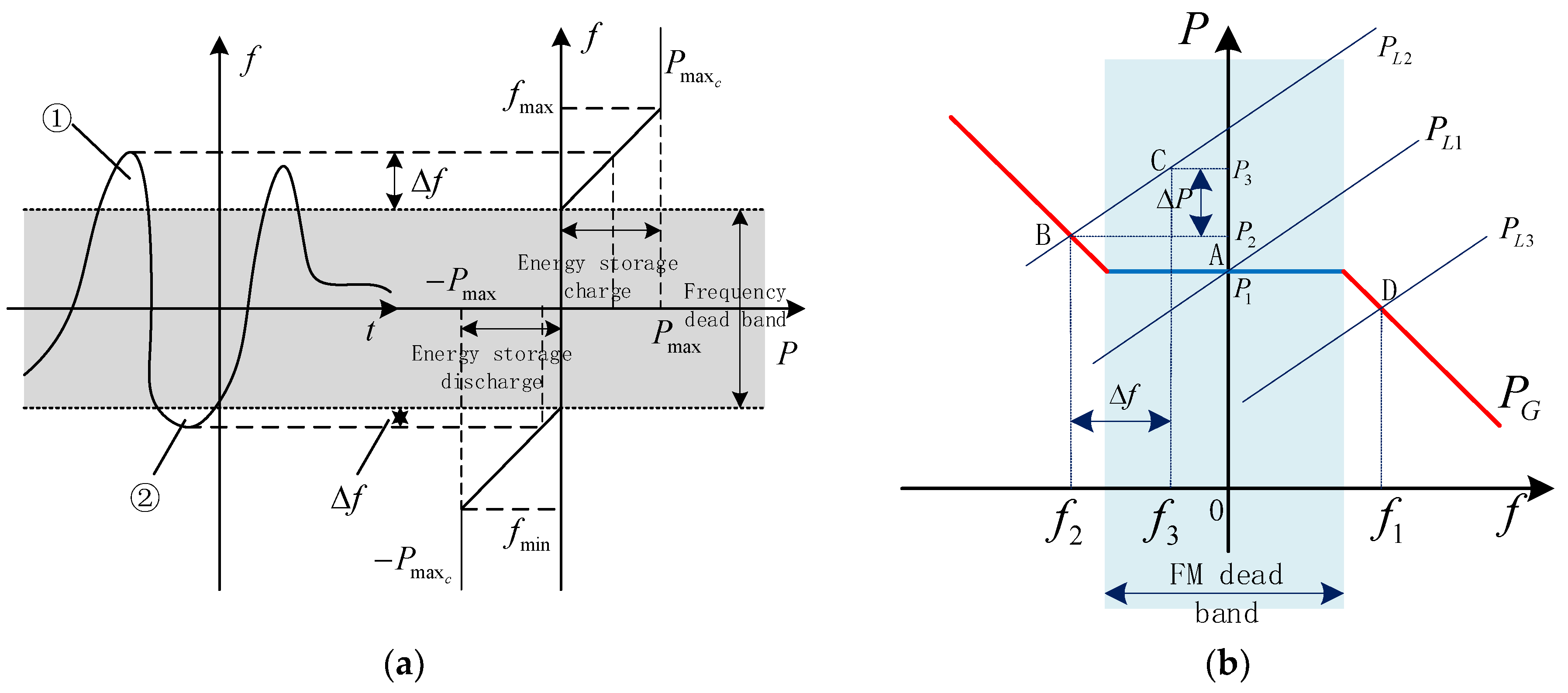
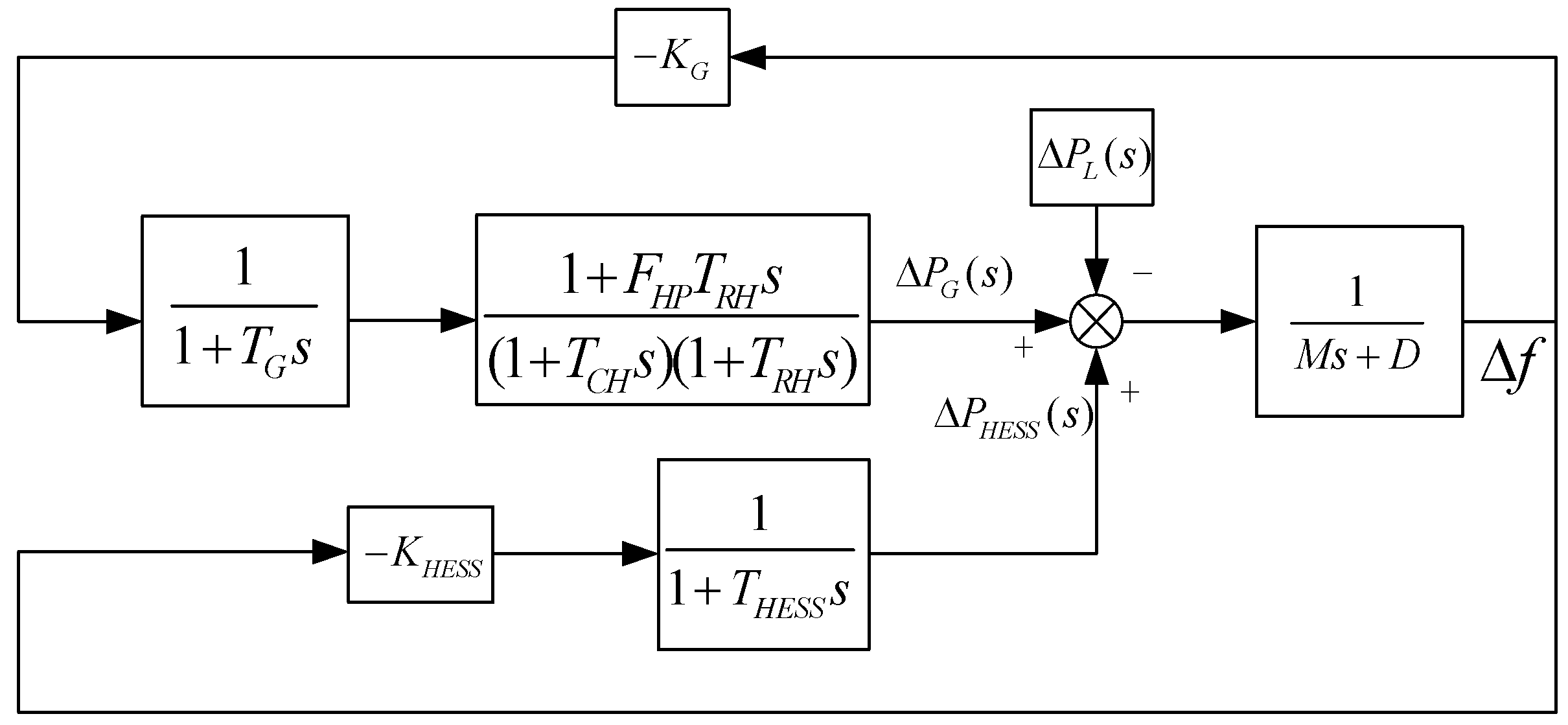
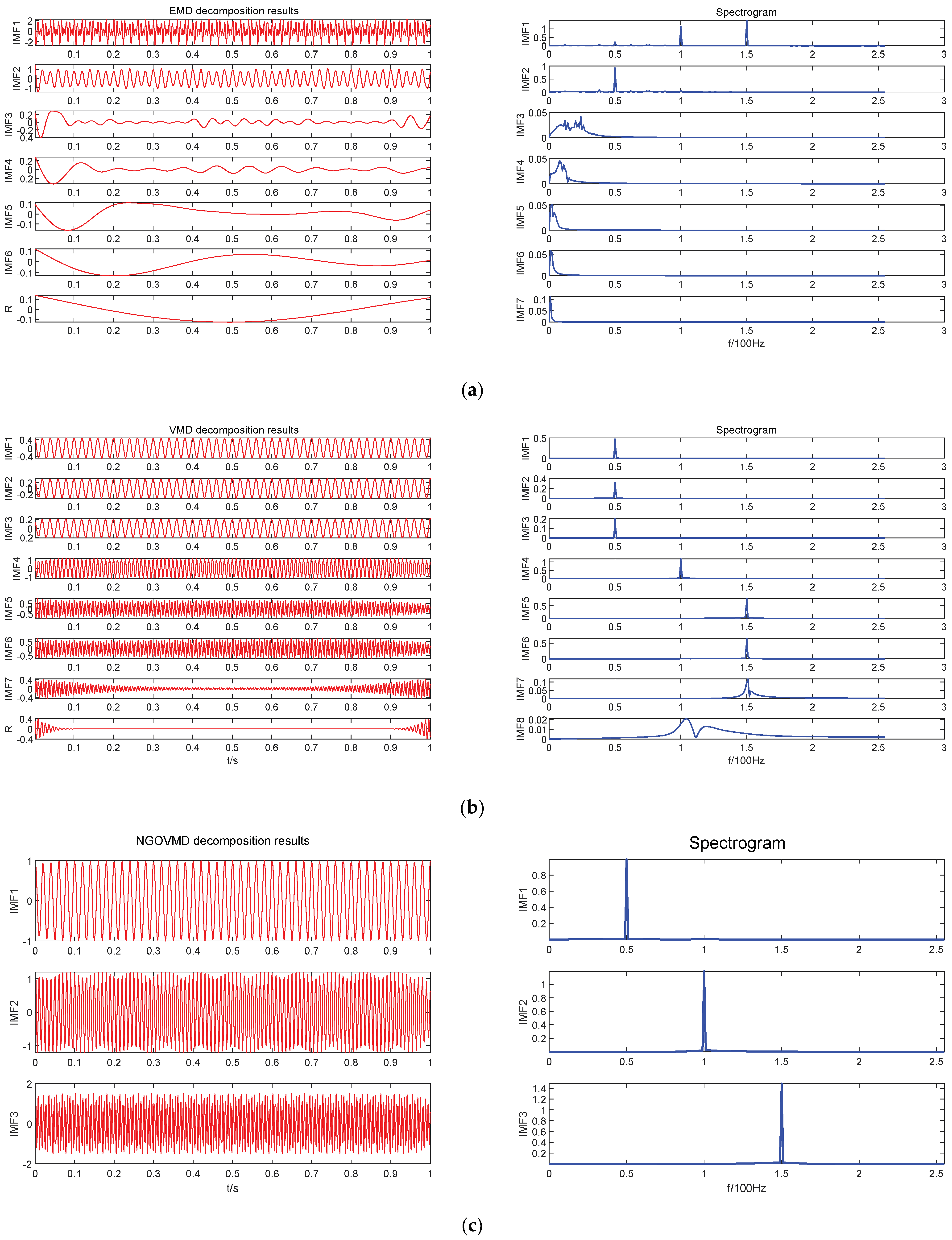
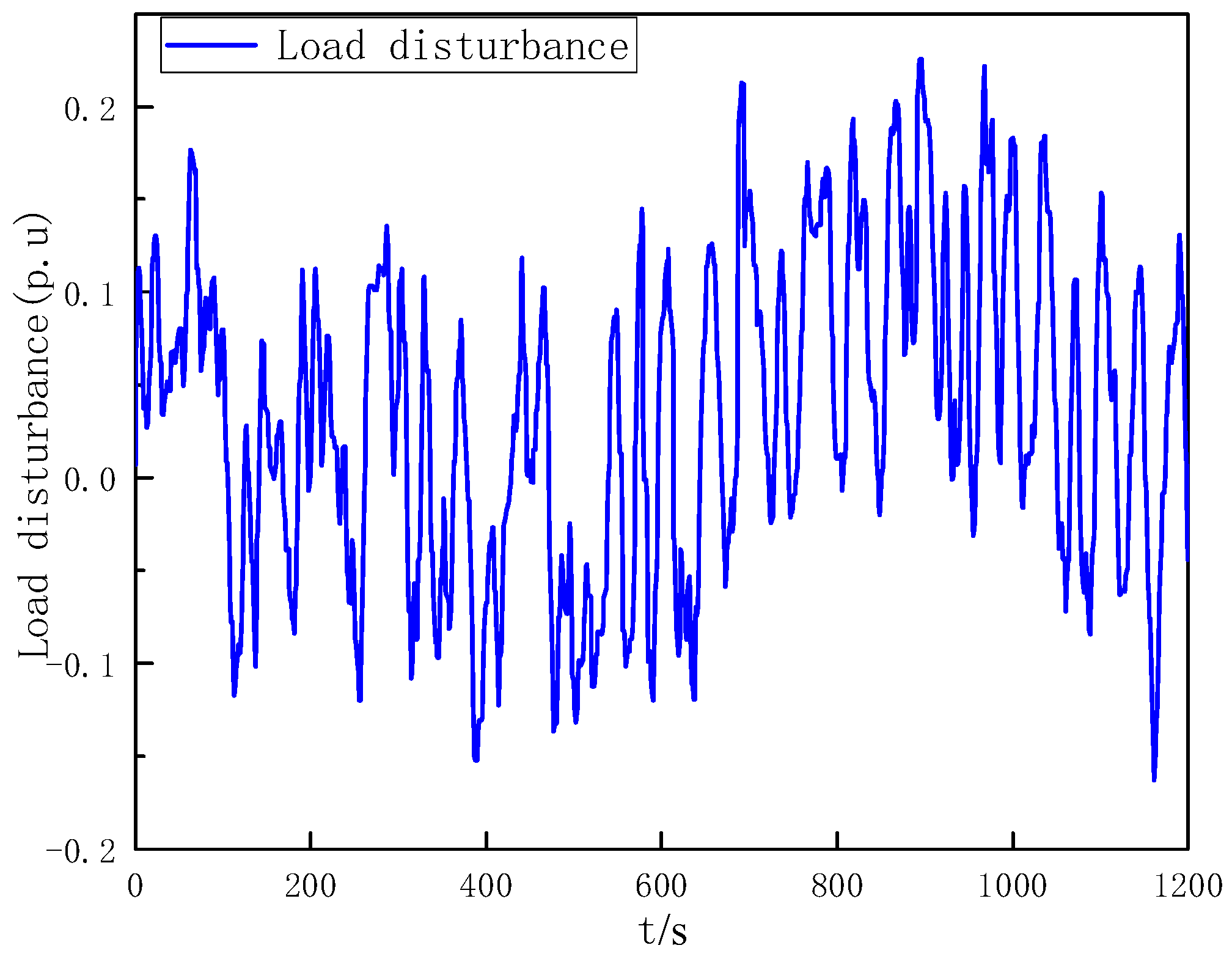

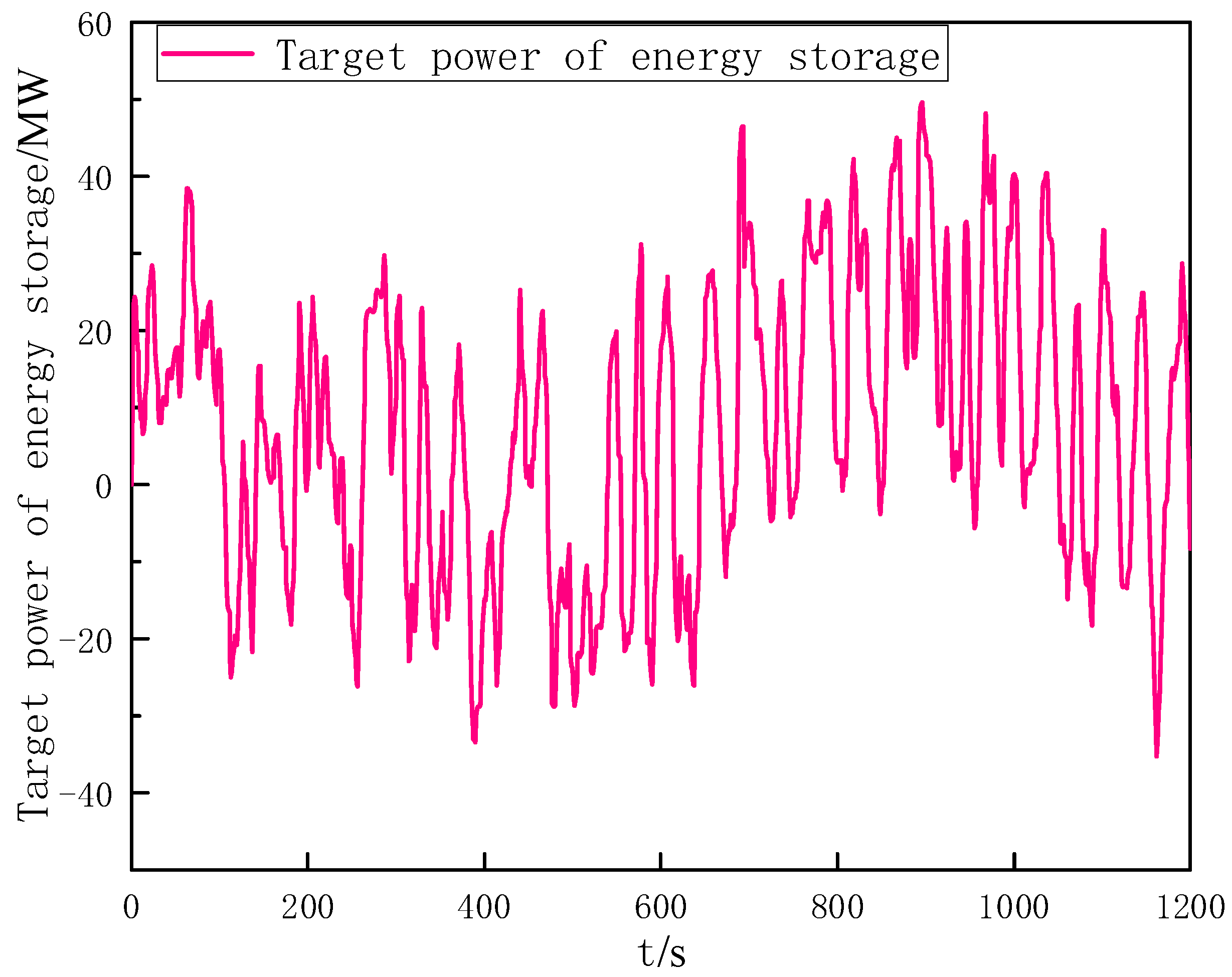


| Parameter | Description | Value |
|---|---|---|
| Rated capacity of the grid | 250 MW | |
| Wind power permeability | 25% | |
| Load disturbance (p.u.) | −0.15~0.2 | |
| Unit regulated power | 24 | |
| D | Load damping factor | 1 |
| M | Constant of inertia | 10 |
| Steam turbine governor | 0.08 | |
| , , | Turbine parameters | 0.3, 10, 0.5 |
| Dead band frequency range | −0.03~0.03 |
| Parameter | Description | Pumped Storage | Lithium Battery | Supercapacitors |
|---|---|---|---|---|
| k1 | Cost per unit of power | 5,000,000 | 300,000 | 450,000 |
| k2 | Cost per unit capacity | 100,000 | 800,000 | 1,500,000 |
| k3 | O&M cost per unit capacity | 10,000 | 20,000 | 20,000 |
| SOC | SOC initial value | 0.5 | 0.5 | 0.5 |
| Y | Operating life (year) | 30 | 9 | 9 |
| Type | Energy storage characteristics | Energy type | Hybrid type | Power type |
| Charge/discharge efficiency | 0.85/0.90 | 0.85/0.85 | 0.90/0.90 | |
| Response time(s) | 10 | 0.1 | 0.001 |
| 1 | 2 | 3 | 4 | 5 | |
|---|---|---|---|---|---|
| IMF1 | L | L | L | L | L |
| IMF2 | M | M | M | M | M |
| IMF3 | H | M | M | M | M |
| IMF4 | H | H | M | M | M |
| IMF5 | H | H | H | M | M |
| IMF6 | H | H | H | H | M |
| IMF7 | H | H | H | H | H |
| H | H | H | H | H |
| Scheme | /MW | /MW | /MW | /MWh | /MWh | /MWh |
|---|---|---|---|---|---|---|
| 1 | 29.45 | 27.48 | 23.06 | 10.57 | 4.67 | 2.64 |
| 2 | 29.45 | 32.95 | 12.70 | 10.57 | 4.58 | 1.24 |
| 3 | 29.45 | 33.34 | 8.02 | 10.57 | 4.60 | 0.67 |
| 4 | 29.45 | 37.65 | 7.81 | 10.57 | 4.64 | 0.45 |
| 5 | 29.45 | 40.21 | 4.78 | 10.57 | 4.61 | 0.30 |
Disclaimer/Publisher’s Note: The statements, opinions and data contained in all publications are solely those of the individual author(s) and contributor(s) and not of MDPI and/or the editor(s). MDPI and/or the editor(s) disclaim responsibility for any injury to people or property resulting from any ideas, methods, instructions or products referred to in the content. |
© 2023 by the authors. Licensee MDPI, Basel, Switzerland. This article is an open access article distributed under the terms and conditions of the Creative Commons Attribution (CC BY) license (https://creativecommons.org/licenses/by/4.0/).
Share and Cite
Zhang, H.; Zhang, X.; Wang, Z.; He, G.; Cui, K.; Wang, X. Capacity Configuration of Hybrid Energy Storage Power Stations Participating in Power Grid Frequency Modulation. Processes 2023, 11, 2843. https://doi.org/10.3390/pr11102843
Zhang H, Zhang X, Wang Z, He G, Cui K, Wang X. Capacity Configuration of Hybrid Energy Storage Power Stations Participating in Power Grid Frequency Modulation. Processes. 2023; 11(10):2843. https://doi.org/10.3390/pr11102843
Chicago/Turabian StyleZhang, Hongtu, Xinyan Zhang, Zhilei Wang, Guangyu He, Ku Cui, and Xianlan Wang. 2023. "Capacity Configuration of Hybrid Energy Storage Power Stations Participating in Power Grid Frequency Modulation" Processes 11, no. 10: 2843. https://doi.org/10.3390/pr11102843




